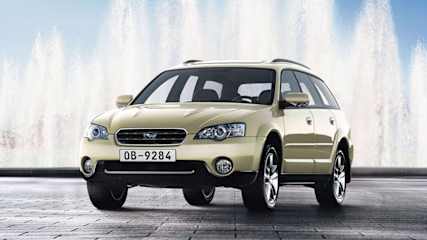Subaru Outback 3.0R 2004 Review
By Staff Writers · 20 Oct 2004
We of the 4WD fraternity thought the divorce papers might be a burned-out engine away, but on the hot tar and gravel of the Red Centre, we were to be proved wrong.The Outback 3.0R behaved with a faithful husband's controlled enthusiasm while hitched – but does the dirty with pleasure once the wedding band is off, and indulges in van-free, off-road fun.For three days, the Outbacks were pushed, ploughed and pummelled – with and without vans – in various conditions, by its unrelenting drivers.The red earth was slung sideways from six wheels as flies swapped shifts with mosquitoes and the temperature raged at 40 degrees. This car would be working hard to perform.It's no easy task for a sport-type vehicle to haul a 1600kg caravan loaded with a score of heavy swags and air-con blasting full bore.Climbing over the tarred switchbacks, the Outback's engine didn't complain. It carried the burden with unsettling ease.Unsettling, because there's no guttural diesel grumble nor any high-riding, ground-crawling 4WD weight (and matching high-riding fuel bill).For big trips, the big 4WDs still win. There's no room in the Outback for spare batteries or long-range fuel tanks, and a low-range crawling gear would be useful to curb the eager sports-shift automatic transmission.But the Outback proved a perfectly capable and versatile vehicle for shorter trips and a medium-sized van in harsh Australian conditions.The Outback 3.0R was designed for this purpose: to look good in the city, where most of its road use will be, but still housing the capabilities of a light, off-road bush-basher.Its three-litre, six-cylinder, horizontally opposed engine is shared with Subaru's popular Liberty.Even with a towing burden, the 180kW (accessed at a high 6600rpm) try their best to respond in sports-car fashion to a toe on the throttle.Over time, the Outback's towing capacity has increased from 1200kg in 1990 up to 1800kg in the current model.Self-levelling suspension adds stability. If it senses the ride is lower on therear wheels from the van, it automatically pumps oil from the suspension reservoir to the main chamber within a few kilometres of travel.The towing pack – a Hayman Reese heavy-duty towbar, a slightly clunky Tekonsha brake controller and the vital transmission cooler – is a $1034 factory-fitted extra.Clearance of 200mm is maintained because the towbar runs inside the chassis rails instead of being bolted to the undercarriage.On the first day, we clocked more than 200 klicks with the 1200kg Jayco Finch pop-top, averaging 17l/100km – about the same as a frugal 4WD in city traffic.Stepping up to the 1600kg Freedom model, the automatic box's gear of choice was third, lag was noticeable and the Outback drank 21.8l/100km.The 1500kg Flamingo, however, ran head-to-head with the 1200kg Finch. Over the 140km with this trailer, the gearing proved ideal, without bouncing back and forth between lower gears.Size still does matter. The Flamingo's longer wheelbase and its Outback Pack, with higher, off-road-rated suspension, nudged the Subaru's nose forward on heavy downhill slopes. Although it never felt out of control, the side-to-side bounce resulting from a too-sharp re-adjustment of direction was noticeable.Vehicle Dynamics Control, available in the Premium-Pack Outlander, is said to have been tested for Australian towing conditions to help curb impertinent nudges from behind.The 3.0R model has shed some pounds, weighing in at 1540kg. Although this is less weight to carry around in everyday driving, the vehicle feels light with a near-capacity weight on the towball.The track has been widened by 20mm at the front and 30mm at the rear, splaying the symmetrical AWD system in a more sturdy position, helped by 50/50 weight distribution hitches (about $600).Making use of the roof rails with a rooftop box to carry spare tyres and heavy, messy equipment may marginally add to stability and decrease any aerodynamic drag at speed. But the effect would probably be minimal and would decrease off-road ability – an area where the Outback is surprisingly capable.Tell-tale scrapes of metal on red rock on "4WD only" roads were only occasionally wince-worthy. Even with pumped-up tyres, the Outback slithered through deep tracks of slippery sand.With a full load of four passengers and luggage, it tackled the jutting rock formations with apparent ease.With 297Nm of torque at our disposal for the tricky situations, we returned to tar, boasting only a superficial scrape or two and having knocked the top cover off the trailer pin plug.Among the lifted 4WD rock-crawlers, the Subarus held up well, bouncing happily and drinking 22l/100km.Rocks should not be taken on with reckless abandon, as some major organs run unprotected under the vehicle.On the could-be-better list: the abrupt lock of the wheel in the turning circle is another reminder that this car is not solely built for hauling, and more feeling in the vague steering would be useful.On downhill gravel, the ABS kicks in with a sickening thump, but to its credit pulls the Outback up short.And though it's a useful city safety feature, the warning beeps when front-seat passengers are slow to buckle up are crying out for a pair of wire-cutters.A vacant space at the top of the console also begs for a GPS system, and Subaru will be testing several platforms over the next few weeks.It's also testing deeper towing waters for the next generation of Outbacks, attempting to overcome engine temperature issues so it can move further into the field of caravans, horse floats and trailers.We can expect to see a two-tonne tow rating with the release of the next Outback model late next year.So the Subaru-and-dirt-road relationship has been strengthened by yet another vehicle, with renewed vows less than a year away.Losing my silent bet that this Outback/caravan combination would fall in an unromantic heap has left me with no choice but to eat my Akubra.













